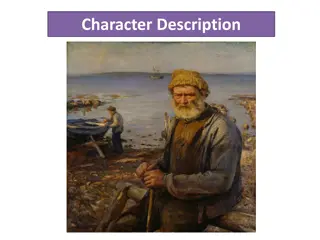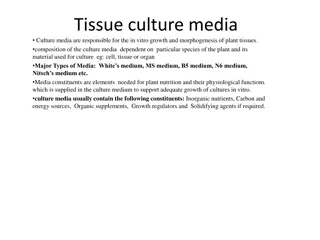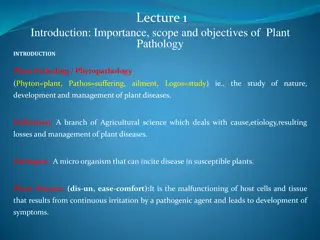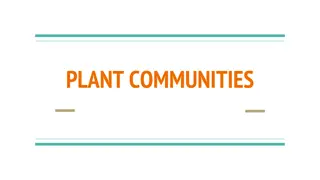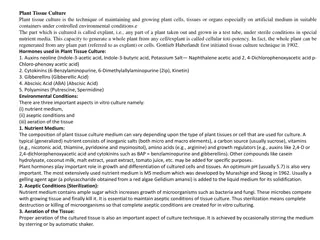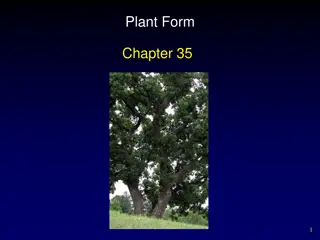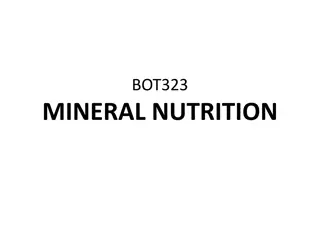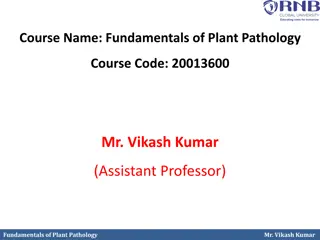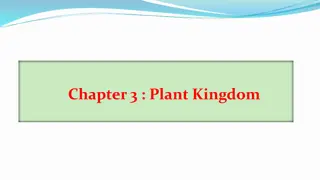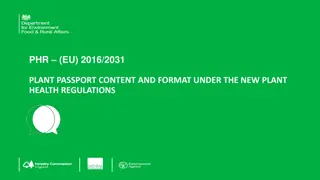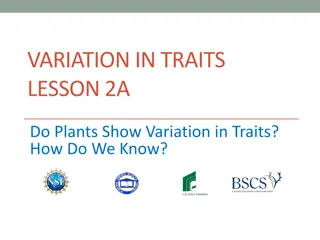Plant Descriptions and Characteristics
Explore descriptions and characteristics of different plant species including Acacia, Bladderpod, Brazilian Pepper, Black Sage, Bulrush, and California Blackberry. Each plant's unique features, location, chemical composition, uses, and family classification are highlighted, along with images for visual reference.
Download Presentation

Please find below an Image/Link to download the presentation.
The content on the website is provided AS IS for your information and personal use only. It may not be sold, licensed, or shared on other websites without obtaining consent from the author.If you encounter any issues during the download, it is possible that the publisher has removed the file from their server.
You are allowed to download the files provided on this website for personal or commercial use, subject to the condition that they are used lawfully. All files are the property of their respective owners.
The content on the website is provided AS IS for your information and personal use only. It may not be sold, licensed, or shared on other websites without obtaining consent from the author.
E N D
Presentation Transcript
Acacia (Golden Wattle) (Acacia pycnantha) Description: Phyllodes: modified petioles (parallel veins) Evergreen Fruit: Legume Flower: Yellow Location: Non-native Originated in Australia Chemical: Tannins Uses: Perfume Family: Fabaceae (Pea family)
Bladderpod (Isomeris arborea) Description Compound leaves with 3 leaflets Leaves alternate Evergreen Fruit: Capsule Flower: Yellow Location: Native Endemic to Southern California Found in coastal sage scrub (CSS) and desert habitats in Southern California Chemical: Strong odor to reduce predation Uses: None Family: Capparaceae
Brazilian Pepper (Schinus terebinthifolius) Description: Pinnately compound leaves Leaves alternate Evergreen Fruit: Drupe Flower: Small white Location: Non-native (invasive) Originated in tropical and subtropical South America Chemical: Aromatic sap that may burn May act as a narcotic on birds who eat berries Uses: Ornamental Family: Anacardiaceae (Sumac family)
Black Sage (Salvia mellifera) Description: Simple leaves with small hairs Drought Deciduous Fruit: Schizocarp Flower: Blue or lavender in stacked balls Location: Native Coastal sage scrub (CSS) and chaparral habitats Chemical: Diterpenoids used as pain relievers Uses: Rub on sore feet Chumash brewed as sun tea Nectar used to make honey Family: Lamiaceae (Mint family)
Bulrush (Schoenoplectus californicus) Description Triangular leaf Sedge-like Fruit: Grain Flower: Brown or tan panicle inflorescence Location: Native Indicator of freshwater in North and South America Chemical: None Uses: Used by Native Americans to make baskets, rope, canoes Family: Cyperaceae
California Blackberry (Rubus ursinus) Description Leaves usually have 3 leaflets but sometimes 5 or only 1 Branches with prickles Usually Deciduous Fruit: Aggregate fruit made up of numerous duplets Flower: White with narrow petals Location: Native Common in moist and shaded shrublands, streamsides, disturbed areas, and canyons Western U.S. Chemical: None Uses: Used by Native Americans as a food Family: Rosaceae (Rose family)
California Buckeye (Aesculus californica) Description Palmately Compound with five leaflets Deciduous Fruit: Capsule Flower: Large white to pink Location: Native to northern California Only buckeye species endemic to California Chemical: Neurotoxic glycoside aesculin, which causes hemolysis of red blood cells. Uses: Used by Native Americans to kill fish Toxic to honeybees Family: Sapindaceae
California Buckwheat (Eriogonum fasciculatum) Description: Leaves in clusters Evergreen Fruit: Grain Flower: White or brown clusters Location: Native Coastal sage scrub and chaparral habitats Chemical: None Uses: Treatment of headache, diarrhea, and wounds Good for heart Erosion control Source of food for honeybees in summer months Family: Polygonaceae
California Redbud (Cercis occidentalis) Description: Simple heart-shaped leaves Deciduous Fruit: Legume Flower: Large Pink or red Location: Native Chaparral habitats in western United States Chemical: None Uses: Wood Veneer Erosion control Red bark used for baskets Family: Fabeaceae (Pea family)
California Sagebrush (Artemisia californica) Description Slender flexible stems with thin pinnate leaves Evergreen Fruit: Achene Flower: Narrow inflorescence which are yellowish Location: Native Coastal sage scrub and chaparral habitats Chemical: Terpenes to reduce competition and predation Uses: Erosion control Reduce digestive issues Family: Asteraceae (Sunflower family)
Caster Bean (Ricinus communis) Description: Palmate alternate Leaves Evergreen Fruit: Spiny capsule (not a true bean) Flower: Panicle-like inflorescence which are reddish in color Location: Non-native (invasive) Originally from Asia and Africa Chemical: Ricin (deadly) Uses: Source of Caster Oil used for digestive cleansing lubricant Family: Euphorbiaceae
Catalina Cherry (Prunus ilicifolia) Description: Simple toothed alternating leaves (vary) Evergreen Fruit: Drupe with large pit Flower: Small white Location: Native California chaparral Chemical: Tannins Uses: Native Americans made a fermented drink Family: Rosaceae (Rose Family)
Catalina Ironwood (Lyonothamnus floribundus) Description: Compound Leaves (fernlike) Evergreen Fruit: Capsule Flower: Cream colored Location: Native Endemic to Catalina Island Chemical: None Uses: Ornamental but seeds not very viable Family: Rosaceae (Rose family)
Cattail (Typha sp.) Description Flat simple leaf Evergreen Fruit: Nut Flower: Dense Brown Spike (wind dispersed) Location: Native Indicator of fresh water in Northern Hemisphere Chemical: None Uses: Rhizomes are edible Leaves can be woven in to baskets or braided into rope Family: Typhaceae
Ceonothus (Mt. Lilac) (Ceonothus sp.) Description: Simple leaf with three prominent veins Evergreen Fruit: Capsule Flower: Blue Location: Native California chaparral Chemical: None Uses: Eaten by Deer Used for teas Baskets Family: Rhamnaceae
Coast Live Oak (Quercus agrifolia) Description: Simple convex leaves with dentate margins Hairs in axils in leaves Evergreen No undergrowth due to shade and Tannins Fruit: Nut Flower: Catkins Location: Native Oak woodlands, chaparral and CSS habitats Chemical: Tannins Uses: Food Charcoal Family: Fagaceae
Coffee Berry (Rhamnus californica) Description: Simple, reddish bark on stems Evergreen Fruit: Drupe Flower: Greenish Location: Native Southwestern United States, Chaparral Chemical: none Uses: Ornamental not as well liked by deer Erosion control Heal burns and rashes Used as laxative Family: Rhamnaceae
Coyote Bush (Baccharis pilularis) Description Simple leaves that are often sticky Various shapes determined by location Large root system Fruit: Achenes Flower: Small white or yellow Location: Native CSS and chaparral habitats in western United States Chemical: Oils to prevent predation Uses: Secondary pioneer plant Family: Asteraceae (Sunflower family)
Crepe Myrtle (Lagerstroemia sp.) Description Simple leaves that are opposite Entire Margins Deciduous Fruit: Capsule Flower: Small crepe like flowers ranging from Red to pink to white Location: Non-native Found on the Indian continent, Southeast Asia and Northern Australia Chemical: None Uses: Ornamental The timber of some species has been used to manufacture bridges, furniture, and railway sleepers Family: Lythraceae
Blue Elderberry (Sambucus nigra) Description Pinnately compound leaves with 5-9 leaflets Deciduous Fruit: True berry Flower: Yellow in an umbrella structure Location: Native Coastal sage scrub and chaparral habitats Chemical: None Uses: Edible fruits Wine Syrup Family: Adoxaceae
Encelia or Brittlebush (Encelia sp.) Description: White leaves Evergreen Fruit: Acene Flower: Yellow Location: Native Coastal sage scrub and desert habitats Chemical: None Uses: Glue, Sealer, Gum, Incense Treat toothaches Family: Asteraceae (Sunflower family)
Eucalyptus (Eucalyptus sp.) Description: 700 species Alternate simple leaves Evergreen Gum Trees Peeling bark Fruit: Capsule Flower: Vary in color with an operculum Location: Non-native (Invasive) Originally from Australia Chemical: Terpenoids (aromatic) Uses: Planted to lower the water table Make pulp for paper Antiseptic Food additives Insect repellent Family: Myrtaceae
Flannel Bush (Fremontodendron sp.) Description: Simple 3-lobed leaves Evergreen Fuzzy texture modified hairs called trichomes Fruit: Capsule Flower: Large yellowish orange Flowers Location: Native Southwestern U.S. and Mexico Chaparral, pine woodlands, and juniper woodland habitats Chemical: None Uses: Water conservation gardens Family: Malvaceae
Fremont Cottonwood (Populus fremontii) Description: Simple leaf with long flattened petiole Deciduous Fruit: Achene Flower: Catkins Location: Native Riparian habitats Southwest U.S. and Northern Mexico Chemical: None Uses: Erosion control Fuel and fence posts Family: Salicaceae
Desert Willow (Chilopsis linearis) Chemical None Uses: Wood used to make bows and baskets Used to treat fungal infections Family: Oleaceae Description: Simple leaf with long flattened petiole Deciduous Fruit: Drupe Flower: Large white or pinkish Location: Native Desert habitats in southwestern U.S
Ginkgo (Ginkgo biloba) Description: Simple leaf which is fan shaped Deciduous Fruit: None Flower: None Location: Non-native Originated in China Chemical: Butyric Acid Uses: Decorative ornamental only males planted in this country Family: Ginkgoaceae
Horehound (Marrubium vulgare) Description Simple leaf with crinkled appearance Fruit: Berry Flower: White clusters on stem Location: Non-native Originally from Europe, Africa and Asia Chemical: Essential oils Uses: Antimicrobial and anticancer properties Candy Grasshopper repellent Invasive Weed Family Laminaceae (Mint family)
Incense Cedar (Calocedrus decurrens) Description: Scaled leaves in flat sprays Branches Flexible Fruit: None Flower: None Location: Native Evergreen forests in western North America Chemical: None Uses: Pencils Light fires Family: Cupressaceae
Indian Paintbrush (Castilleja sp.) Description: Clover like leaves Fruit: Capsule Flower: Red, orange to yellow (bracts) Location: Native Various habitats in western North America Chemical: None Uses: Eaten as greens Hairwash Dye Family: Orobanchaceae
Jacaranda (Jacaranda sp.) Description: Doubly compound leaves Fruit: Capsule Flower: Purple often sticky Location: Non-native Originally from Central and South America Chemical: None Uses: Ornamental plants Acoustic guitars Family: Bignoniaceae
Jimson Weed (Datura stramonium) Description Large simple toothed leaves Fruit: Capsule Flower: Large white to purple Location: Native Coastal sage scrub, desert, and chaparral habitats Widespread throughout North and South America Chemical: Atropine Uses: Relieve asthma symptoms Hallucinogen Family: Solanaceae
Jojoba (Simmondsia chinensis) Description: Simple leaves that stand erect Fruit: Capsule Flower: Small greenish yellow Location: Native Chaparral and desert habitats in western North America Chemical Oil (liquid wax ester) Uses: Laxative Salve Biodiesel fuel Cosmetics Family: Simmondsiaceae
Laurel Sumac (Malosma laurina) Description; Large Simple Leaves with reddish edges Fruit: Drupe Flower: Small white Location: Native Coastal sage scrub and Chaparral habitats Chemical: Volatile compounds Uses: Tea for dysentery Crown sprouting Fire adapted Family: Anacardiaceae (Sumac family)
Lemonade Berry (Rhus integrifolia) Description: Large Simple and alternating Evergreen Reddish twigs Leaf margins may be serrated Fruit: Berry Flower: Small rosy pink Location: Native Coastal sage scrub and chaparral habitats Chemical: Tannins Uses: Lemonade like drink Make candles Family: Anacardiaceae (Sumac family)
Liquid Amber (Lizuidamber styraciflua) Description: Large Simple and palmate Deciduous Fruit: Woody Capsule Flower: Greenish Location: Non-native Originally from deciduous forests in eastern U.S. Chemical: Styrax Uses: Plywood, furniture, cabinets Chewing gum Family: Altingiaceae
Mesquite (Prosopis sp.) Description Deciduous Doubly pinnate compound leaves Long Taproot (up to 200 ft) Thorns Fruit: Legume Flower: Catkins with pale green or yellow flowers Location: Native Desert habitats in southwestern U.S Chemical: None Uses: Food (flour) Furniture Barbecues Family: Fabaceae (Pea family)
Monkey Flower (Mimulus aurantiacus) Description Deep Green Sticky Leaves Fruit: Capsule Flower: Tubular flowers that are red to orange in color Location: Native Disturbed sandy habitats Chemical: None Uses: Native Americans used the plant to treat minor ailments such as sores, burns, diarrhea, and eye irritation. Family: Phrymaceae
Mulefat (Baccharis salicifolia) Description: Simple Leaves Sticky foliage Fruit: Small achene Flower: Small fuzzy pink or red-tinged white flowers Location: Native Coastal sage scrub, chaparral, and riparian habitats in western U.S Chemical: None Uses: Erosion control Family: Asteraceaea (Sunflower family)
Mustard (Bassica sp.) Description: Annual Fruit: Silque Flower: Yellow Location: Non-native (Invasive) Originally from Mediterranean region Chemical Allelochemicals inhibit mychorrhizae of neighboring plants Uses: Pioneer plant (indicator of distrubance) Cooking oil Spice High in Vitamin C Family: Brassicaceae (Mustard family)
Olive (Olea europaea) Description: Small evergreen tree with small oblong leaves that are dark green on the top, silvery on the bottom Fruit: Drupe Flower: Small white feathery flowers in racemes Location: Non-native Originally from Mediterranean region, Asia and Africa Chemical Oleuropein makes olives bitter. Olives are fermented to use as food Uses: Food (Olives are artificially black by adding the chemical ferrous sulfate 90% of olives are used as olive oil Has been used as a symbol of peace Family: Oleaceae
Palm Tree (Washingtonia sp.) Description: Evergreen Skirt Near water (Oasis) Fruit: Drupe Flower: Small and insignificant Location: Native or Non-native Desert habitats in Mexico and southern California Chemical: None Uses: Food Baskets Thatch Roofs Family: Arecaceae
Palo Verde (Parkinsonia microphylla) Description: Green bark Small leaves that are drought deciduous Fruit: Legume Flower: Pale yellow Location: Native Desert habitats in southwestern U.S Chemical: None Uses: Food (flour) Family: Fabaceae (Pea family)
Pampas Grass (Cortaderia selloana) Description: Tall grass with leaves that cut when going toward center of plant Fruit: Grain Flower: Dense white panicles Location: Non-native (Invasive) Riparian habitats Originally from South America Chemical: None Uses: Flower arrangements Family: Poaceaea (Grass family)
Pine Tree (Pinus sp.) Description: Leaves are needles grouped into fascicles Branches flexible Fruit: None Flower: None Location: Native Evergreen forests worldwide Chemical: None Uses: Wood Furniture, floors Family: Pinaceae
Pricklypear Cactus (Opuntia littoralis) Description: Leaves modified into Glochids Stems modified as Chladophylls Fruit: Fleshy red fruit (pear) Flower: Yellow to red Location: Native Found in coastal sage scrub and desert habitats in southwestern United States Chemical: None Uses: Can be eaten Family: Cactaceae (Cactus family)
Sago Palm (Cycas revoluta) Description: Palm-like Fruit: None Flower: None Location: Non-native Originally from Japan and China Chemical: Alkaloids, tannins, steroids Uses: Ornamental Family: Cycadaceae
Southern Black Walnut (Juglans nigra) Description: Compound leaves Deciduous Slight odor Fruit: Drupe Flower: Green catkins Location: Native Riparian habitats Endemic to California Chemical: None Uses: Flooring, furniture Food Family: Juglandaceae
Southern Magnolia (Magnolia grandiflora) Description Thick Waxy Leaves with rusty pubescence underneath Fruit: Follicle Flower: Large White Location: Non-native Originally from southeastern U.S. Chemical None Use Ornamental Make furniture, pallets and veneer Family Magnoliaceae
Stinging Nettle (Urtica sp.) Description Small perennial plant with serrated leaves and trichomes Fruit: Achene Flower: Small greenish or brownish in an inflorescence Location: Native Western United States Chemical Acetylcholine, histamine, formic acid Use Food Family Urticaceae


